Arden University BUS5002D: Business Process Analysis Report
VerifiedAdded on 2022/12/27
|23
|4934
|60
Report
AI Summary
This report analyzes business processes, focusing on quality management approaches and project management principles, using Ford Motor Company as a case study. The report begins with an introduction to quality management, exploring various approaches and their effectiveness within organizations, including a detailed examination of Total Quality Management (TQM) and Six Sigma methodologies employed by Ford. It assesses techniques for measuring project success, considering factors like scope, schedule, budget, stakeholder satisfaction, and quality. Furthermore, the report delves into effective project management principles, such as setting objectives, budgeting, and defining team responsibilities. It also examines techniques for process analysis and improvement, including Pareto Analysis, DMAIC, and EFQM frameworks, with practical applications. The report also identifies opportunities for innovation and growth and suggests an implementation plan for the proposed improvements. Finally, the report concludes with a summary of the findings and recommendations.
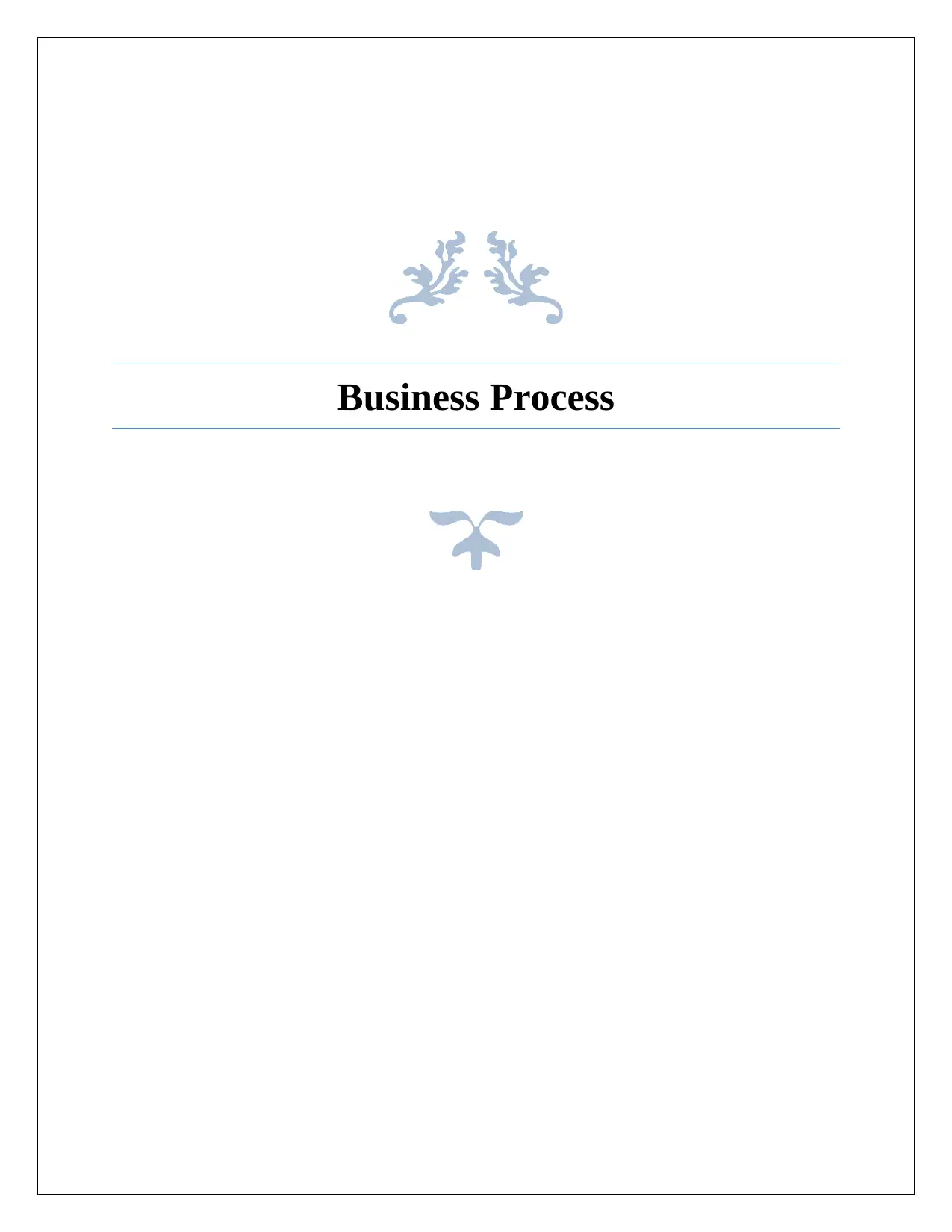
Business Process
Paraphrase This Document
Need a fresh take? Get an instant paraphrase of this document with our AI Paraphraser
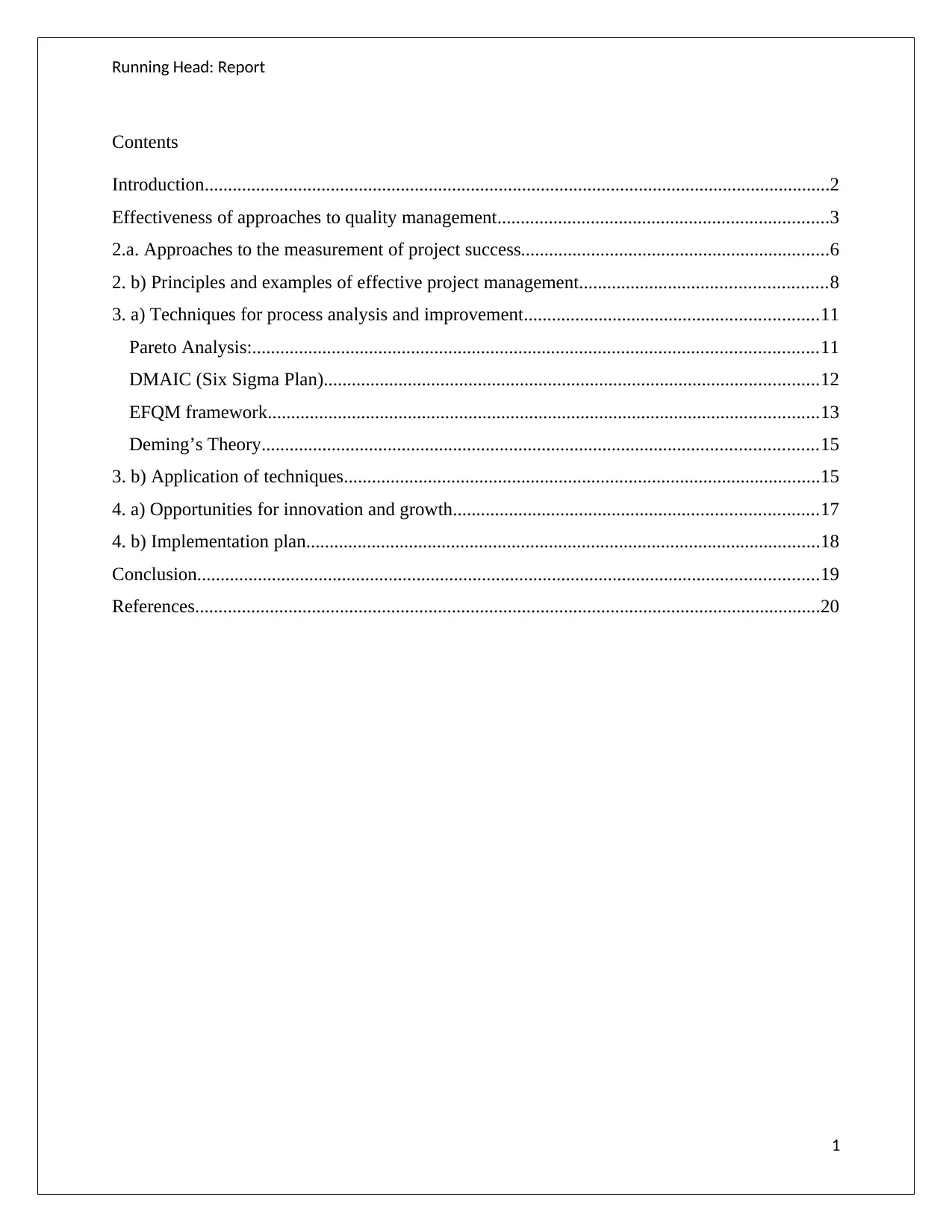
Running Head: Report
Contents
Introduction......................................................................................................................................2
Effectiveness of approaches to quality management.......................................................................3
2.a. Approaches to the measurement of project success..................................................................6
2. b) Principles and examples of effective project management.....................................................8
3. a) Techniques for process analysis and improvement...............................................................11
Pareto Analysis:.........................................................................................................................11
DMAIC (Six Sigma Plan)..........................................................................................................12
EFQM framework......................................................................................................................13
Deming’s Theory.......................................................................................................................15
3. b) Application of techniques......................................................................................................15
4. a) Opportunities for innovation and growth..............................................................................17
4. b) Implementation plan..............................................................................................................18
Conclusion.....................................................................................................................................19
References......................................................................................................................................20
1
Contents
Introduction......................................................................................................................................2
Effectiveness of approaches to quality management.......................................................................3
2.a. Approaches to the measurement of project success..................................................................6
2. b) Principles and examples of effective project management.....................................................8
3. a) Techniques for process analysis and improvement...............................................................11
Pareto Analysis:.........................................................................................................................11
DMAIC (Six Sigma Plan)..........................................................................................................12
EFQM framework......................................................................................................................13
Deming’s Theory.......................................................................................................................15
3. b) Application of techniques......................................................................................................15
4. a) Opportunities for innovation and growth..............................................................................17
4. b) Implementation plan..............................................................................................................18
Conclusion.....................................................................................................................................19
References......................................................................................................................................20
1
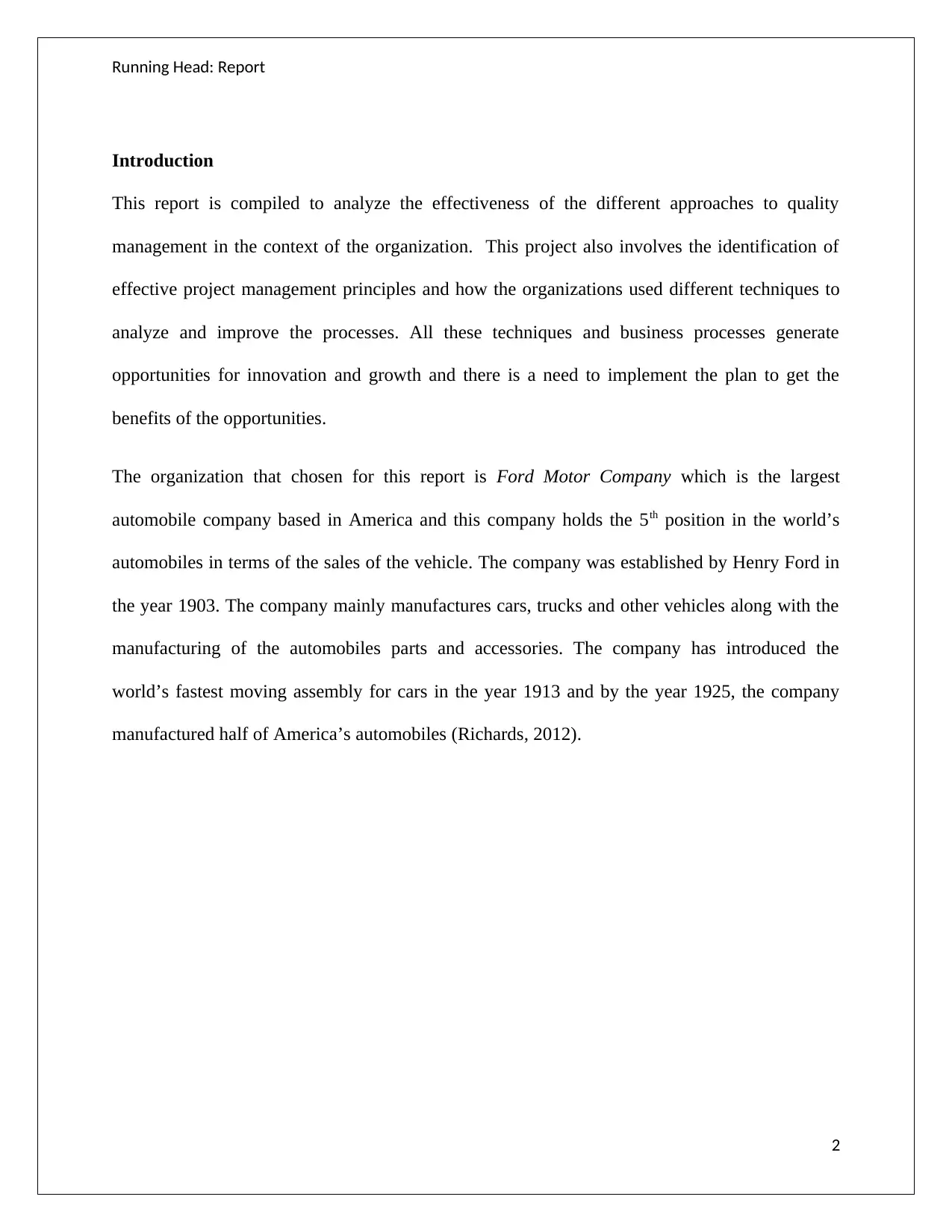
Running Head: Report
Introduction
This report is compiled to analyze the effectiveness of the different approaches to quality
management in the context of the organization. This project also involves the identification of
effective project management principles and how the organizations used different techniques to
analyze and improve the processes. All these techniques and business processes generate
opportunities for innovation and growth and there is a need to implement the plan to get the
benefits of the opportunities.
The organization that chosen for this report is Ford Motor Company which is the largest
automobile company based in America and this company holds the 5th position in the world’s
automobiles in terms of the sales of the vehicle. The company was established by Henry Ford in
the year 1903. The company mainly manufactures cars, trucks and other vehicles along with the
manufacturing of the automobiles parts and accessories. The company has introduced the
world’s fastest moving assembly for cars in the year 1913 and by the year 1925, the company
manufactured half of America’s automobiles (Richards, 2012).
2
Introduction
This report is compiled to analyze the effectiveness of the different approaches to quality
management in the context of the organization. This project also involves the identification of
effective project management principles and how the organizations used different techniques to
analyze and improve the processes. All these techniques and business processes generate
opportunities for innovation and growth and there is a need to implement the plan to get the
benefits of the opportunities.
The organization that chosen for this report is Ford Motor Company which is the largest
automobile company based in America and this company holds the 5th position in the world’s
automobiles in terms of the sales of the vehicle. The company was established by Henry Ford in
the year 1903. The company mainly manufactures cars, trucks and other vehicles along with the
manufacturing of the automobiles parts and accessories. The company has introduced the
world’s fastest moving assembly for cars in the year 1913 and by the year 1925, the company
manufactured half of America’s automobiles (Richards, 2012).
2
⊘ This is a preview!⊘
Do you want full access?
Subscribe today to unlock all pages.

Trusted by 1+ million students worldwide
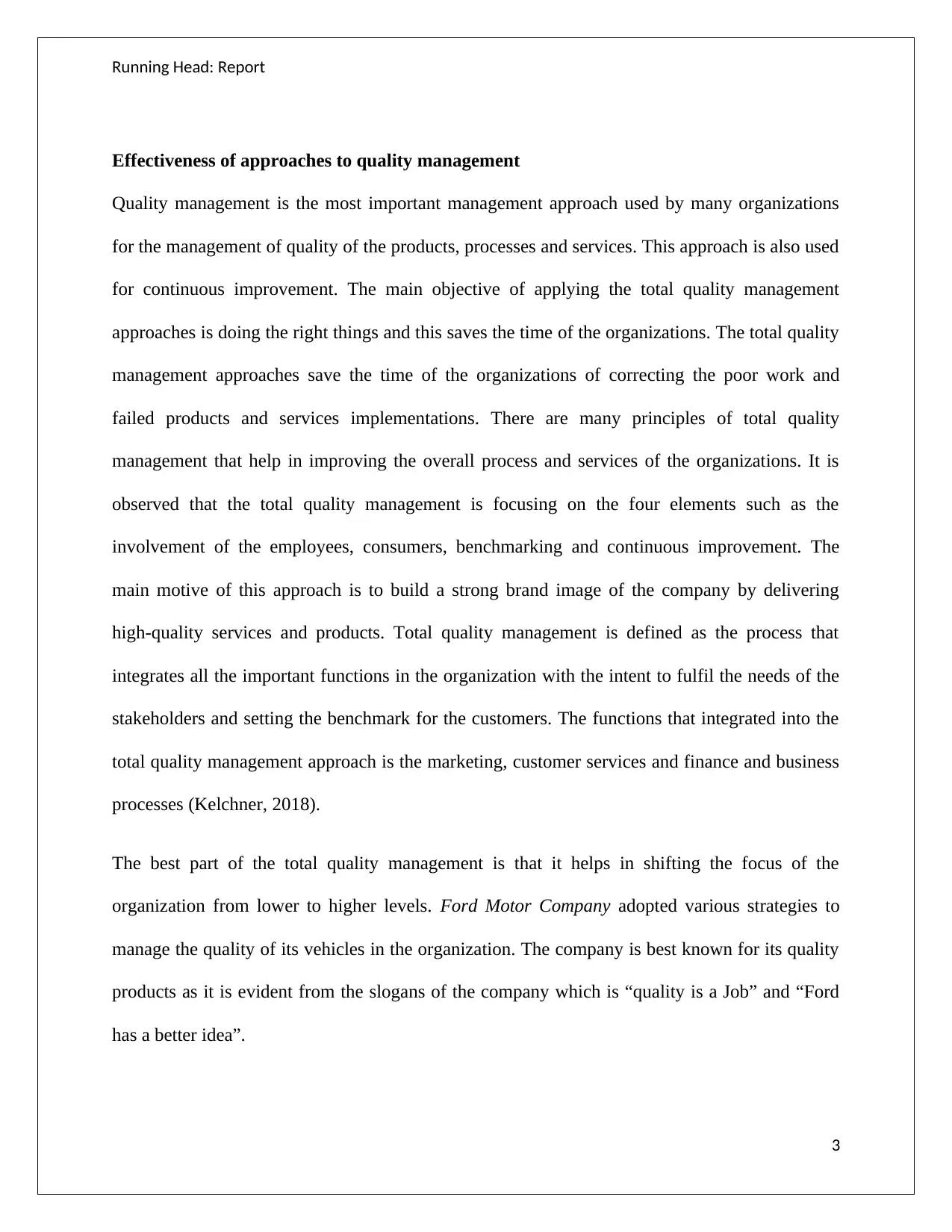
Running Head: Report
Effectiveness of approaches to quality management
Quality management is the most important management approach used by many organizations
for the management of quality of the products, processes and services. This approach is also used
for continuous improvement. The main objective of applying the total quality management
approaches is doing the right things and this saves the time of the organizations. The total quality
management approaches save the time of the organizations of correcting the poor work and
failed products and services implementations. There are many principles of total quality
management that help in improving the overall process and services of the organizations. It is
observed that the total quality management is focusing on the four elements such as the
involvement of the employees, consumers, benchmarking and continuous improvement. The
main motive of this approach is to build a strong brand image of the company by delivering
high-quality services and products. Total quality management is defined as the process that
integrates all the important functions in the organization with the intent to fulfil the needs of the
stakeholders and setting the benchmark for the customers. The functions that integrated into the
total quality management approach is the marketing, customer services and finance and business
processes (Kelchner, 2018).
The best part of the total quality management is that it helps in shifting the focus of the
organization from lower to higher levels. Ford Motor Company adopted various strategies to
manage the quality of its vehicles in the organization. The company is best known for its quality
products as it is evident from the slogans of the company which is “quality is a Job” and “Ford
has a better idea”.
3
Effectiveness of approaches to quality management
Quality management is the most important management approach used by many organizations
for the management of quality of the products, processes and services. This approach is also used
for continuous improvement. The main objective of applying the total quality management
approaches is doing the right things and this saves the time of the organizations. The total quality
management approaches save the time of the organizations of correcting the poor work and
failed products and services implementations. There are many principles of total quality
management that help in improving the overall process and services of the organizations. It is
observed that the total quality management is focusing on the four elements such as the
involvement of the employees, consumers, benchmarking and continuous improvement. The
main motive of this approach is to build a strong brand image of the company by delivering
high-quality services and products. Total quality management is defined as the process that
integrates all the important functions in the organization with the intent to fulfil the needs of the
stakeholders and setting the benchmark for the customers. The functions that integrated into the
total quality management approach is the marketing, customer services and finance and business
processes (Kelchner, 2018).
The best part of the total quality management is that it helps in shifting the focus of the
organization from lower to higher levels. Ford Motor Company adopted various strategies to
manage the quality of its vehicles in the organization. The company is best known for its quality
products as it is evident from the slogans of the company which is “quality is a Job” and “Ford
has a better idea”.
3
Paraphrase This Document
Need a fresh take? Get an instant paraphrase of this document with our AI Paraphraser
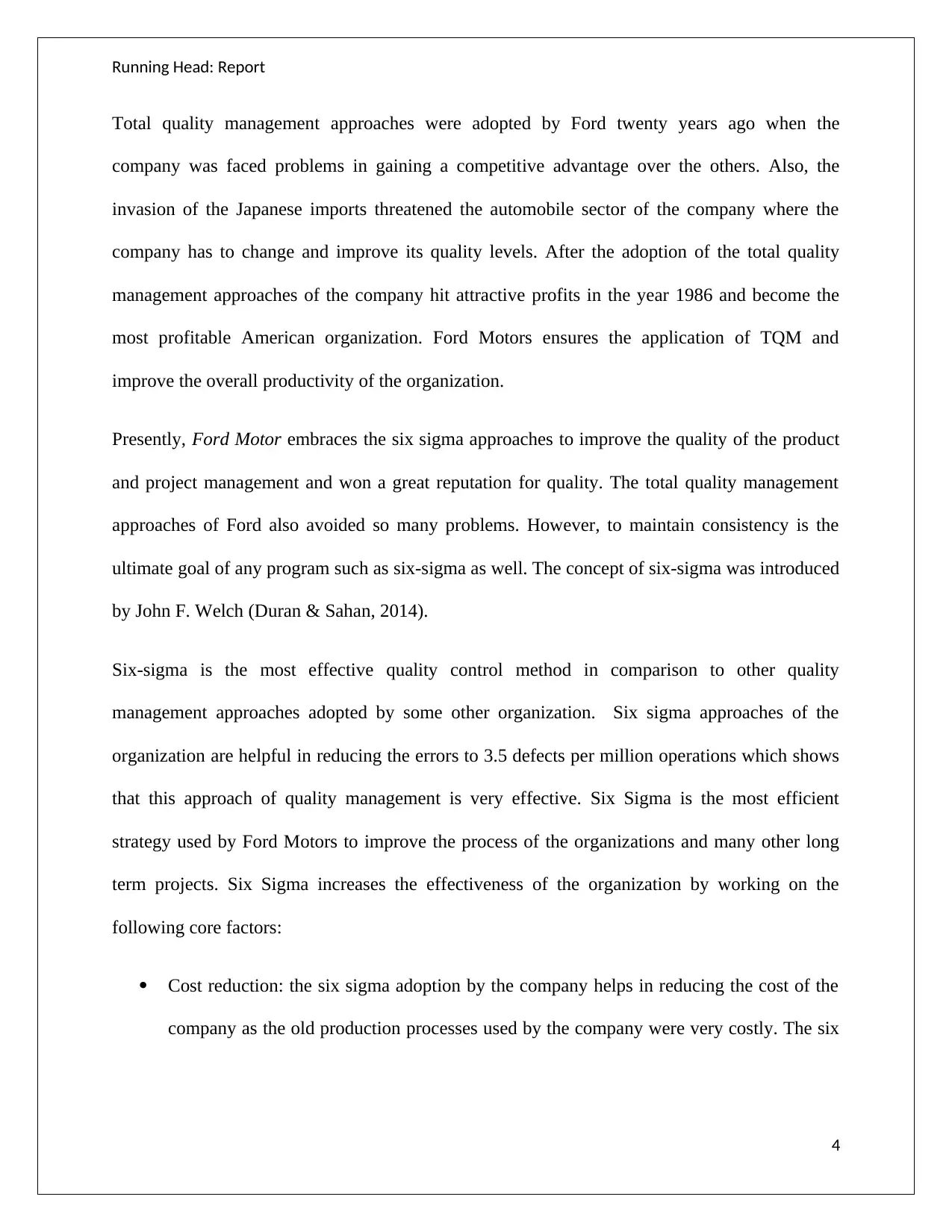
Running Head: Report
Total quality management approaches were adopted by Ford twenty years ago when the
company was faced problems in gaining a competitive advantage over the others. Also, the
invasion of the Japanese imports threatened the automobile sector of the company where the
company has to change and improve its quality levels. After the adoption of the total quality
management approaches of the company hit attractive profits in the year 1986 and become the
most profitable American organization. Ford Motors ensures the application of TQM and
improve the overall productivity of the organization.
Presently, Ford Motor embraces the six sigma approaches to improve the quality of the product
and project management and won a great reputation for quality. The total quality management
approaches of Ford also avoided so many problems. However, to maintain consistency is the
ultimate goal of any program such as six-sigma as well. The concept of six-sigma was introduced
by John F. Welch (Duran & Sahan, 2014).
Six-sigma is the most effective quality control method in comparison to other quality
management approaches adopted by some other organization. Six sigma approaches of the
organization are helpful in reducing the errors to 3.5 defects per million operations which shows
that this approach of quality management is very effective. Six Sigma is the most efficient
strategy used by Ford Motors to improve the process of the organizations and many other long
term projects. Six Sigma increases the effectiveness of the organization by working on the
following core factors:
Cost reduction: the six sigma adoption by the company helps in reducing the cost of the
company as the old production processes used by the company were very costly. The six
4
Total quality management approaches were adopted by Ford twenty years ago when the
company was faced problems in gaining a competitive advantage over the others. Also, the
invasion of the Japanese imports threatened the automobile sector of the company where the
company has to change and improve its quality levels. After the adoption of the total quality
management approaches of the company hit attractive profits in the year 1986 and become the
most profitable American organization. Ford Motors ensures the application of TQM and
improve the overall productivity of the organization.
Presently, Ford Motor embraces the six sigma approaches to improve the quality of the product
and project management and won a great reputation for quality. The total quality management
approaches of Ford also avoided so many problems. However, to maintain consistency is the
ultimate goal of any program such as six-sigma as well. The concept of six-sigma was introduced
by John F. Welch (Duran & Sahan, 2014).
Six-sigma is the most effective quality control method in comparison to other quality
management approaches adopted by some other organization. Six sigma approaches of the
organization are helpful in reducing the errors to 3.5 defects per million operations which shows
that this approach of quality management is very effective. Six Sigma is the most efficient
strategy used by Ford Motors to improve the process of the organizations and many other long
term projects. Six Sigma increases the effectiveness of the organization by working on the
following core factors:
Cost reduction: the six sigma adoption by the company helps in reducing the cost of the
company as the old production processes used by the company were very costly. The six
4
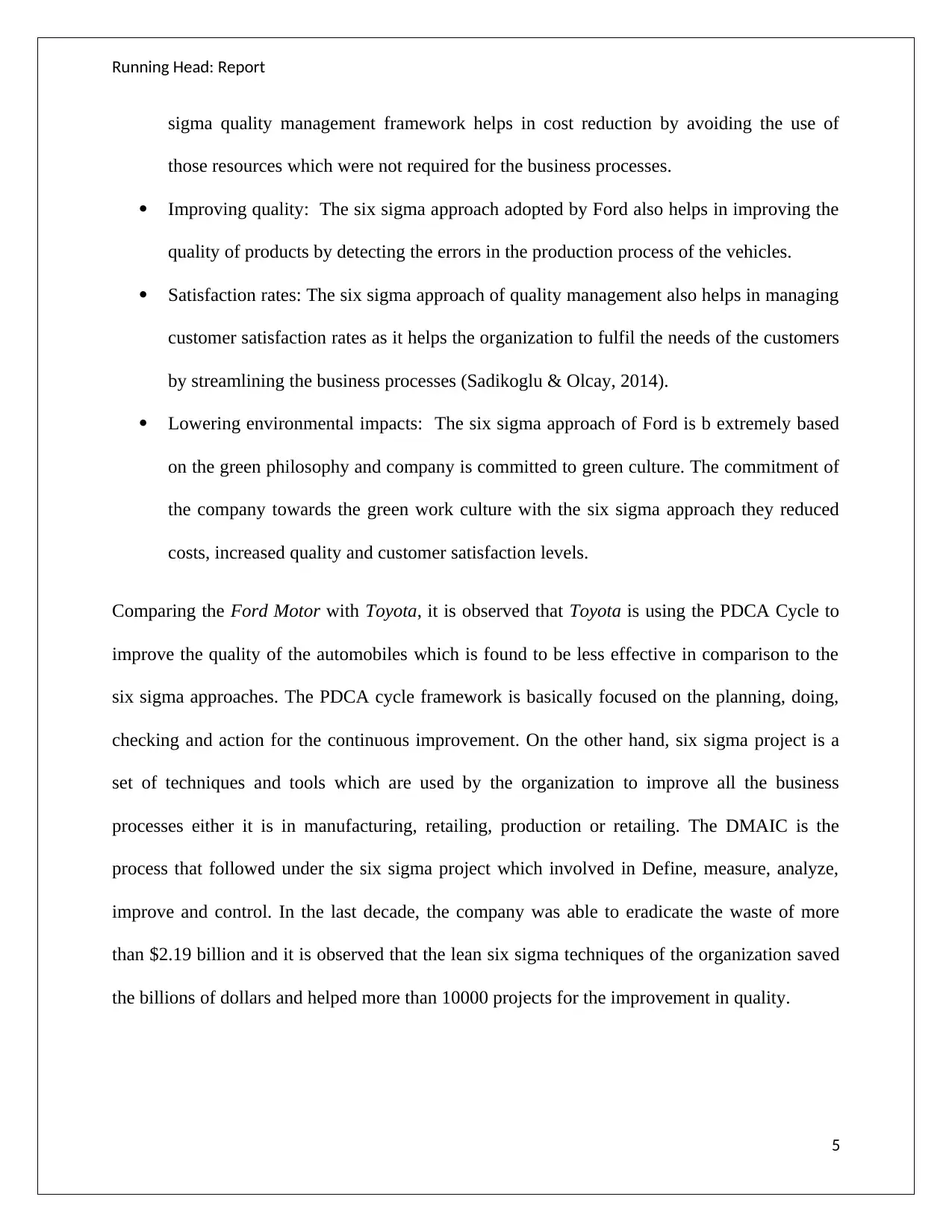
Running Head: Report
sigma quality management framework helps in cost reduction by avoiding the use of
those resources which were not required for the business processes.
Improving quality: The six sigma approach adopted by Ford also helps in improving the
quality of products by detecting the errors in the production process of the vehicles.
Satisfaction rates: The six sigma approach of quality management also helps in managing
customer satisfaction rates as it helps the organization to fulfil the needs of the customers
by streamlining the business processes (Sadikoglu & Olcay, 2014).
Lowering environmental impacts: The six sigma approach of Ford is b extremely based
on the green philosophy and company is committed to green culture. The commitment of
the company towards the green work culture with the six sigma approach they reduced
costs, increased quality and customer satisfaction levels.
Comparing the Ford Motor with Toyota, it is observed that Toyota is using the PDCA Cycle to
improve the quality of the automobiles which is found to be less effective in comparison to the
six sigma approaches. The PDCA cycle framework is basically focused on the planning, doing,
checking and action for the continuous improvement. On the other hand, six sigma project is a
set of techniques and tools which are used by the organization to improve all the business
processes either it is in manufacturing, retailing, production or retailing. The DMAIC is the
process that followed under the six sigma project which involved in Define, measure, analyze,
improve and control. In the last decade, the company was able to eradicate the waste of more
than $2.19 billion and it is observed that the lean six sigma techniques of the organization saved
the billions of dollars and helped more than 10000 projects for the improvement in quality.
5
sigma quality management framework helps in cost reduction by avoiding the use of
those resources which were not required for the business processes.
Improving quality: The six sigma approach adopted by Ford also helps in improving the
quality of products by detecting the errors in the production process of the vehicles.
Satisfaction rates: The six sigma approach of quality management also helps in managing
customer satisfaction rates as it helps the organization to fulfil the needs of the customers
by streamlining the business processes (Sadikoglu & Olcay, 2014).
Lowering environmental impacts: The six sigma approach of Ford is b extremely based
on the green philosophy and company is committed to green culture. The commitment of
the company towards the green work culture with the six sigma approach they reduced
costs, increased quality and customer satisfaction levels.
Comparing the Ford Motor with Toyota, it is observed that Toyota is using the PDCA Cycle to
improve the quality of the automobiles which is found to be less effective in comparison to the
six sigma approaches. The PDCA cycle framework is basically focused on the planning, doing,
checking and action for the continuous improvement. On the other hand, six sigma project is a
set of techniques and tools which are used by the organization to improve all the business
processes either it is in manufacturing, retailing, production or retailing. The DMAIC is the
process that followed under the six sigma project which involved in Define, measure, analyze,
improve and control. In the last decade, the company was able to eradicate the waste of more
than $2.19 billion and it is observed that the lean six sigma techniques of the organization saved
the billions of dollars and helped more than 10000 projects for the improvement in quality.
5
⊘ This is a preview!⊘
Do you want full access?
Subscribe today to unlock all pages.

Trusted by 1+ million students worldwide
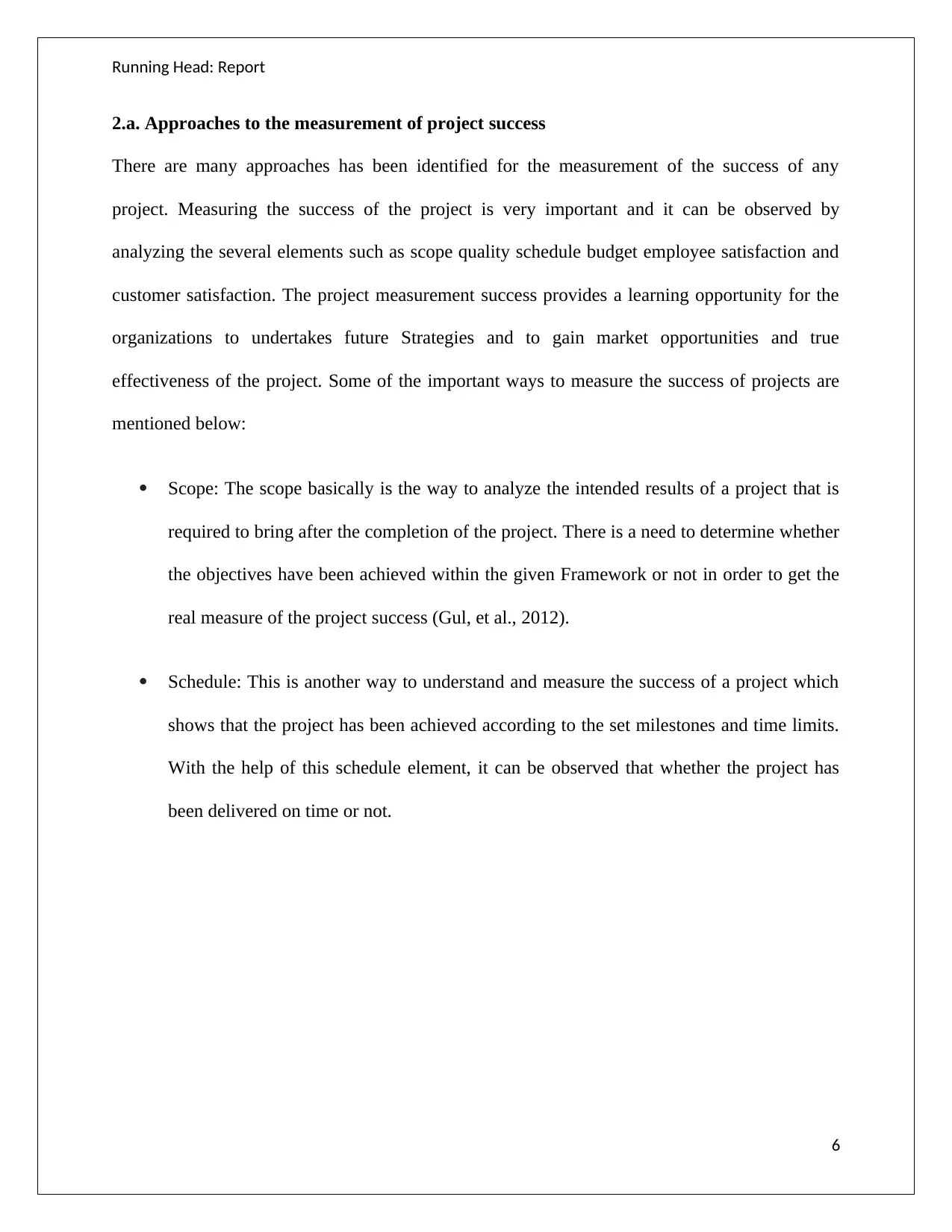
Running Head: Report
2.a. Approaches to the measurement of project success
There are many approaches has been identified for the measurement of the success of any
project. Measuring the success of the project is very important and it can be observed by
analyzing the several elements such as scope quality schedule budget employee satisfaction and
customer satisfaction. The project measurement success provides a learning opportunity for the
organizations to undertakes future Strategies and to gain market opportunities and true
effectiveness of the project. Some of the important ways to measure the success of projects are
mentioned below:
Scope: The scope basically is the way to analyze the intended results of a project that is
required to bring after the completion of the project. There is a need to determine whether
the objectives have been achieved within the given Framework or not in order to get the
real measure of the project success (Gul, et al., 2012).
Schedule: This is another way to understand and measure the success of a project which
shows that the project has been achieved according to the set milestones and time limits.
With the help of this schedule element, it can be observed that whether the project has
been delivered on time or not.
6
2.a. Approaches to the measurement of project success
There are many approaches has been identified for the measurement of the success of any
project. Measuring the success of the project is very important and it can be observed by
analyzing the several elements such as scope quality schedule budget employee satisfaction and
customer satisfaction. The project measurement success provides a learning opportunity for the
organizations to undertakes future Strategies and to gain market opportunities and true
effectiveness of the project. Some of the important ways to measure the success of projects are
mentioned below:
Scope: The scope basically is the way to analyze the intended results of a project that is
required to bring after the completion of the project. There is a need to determine whether
the objectives have been achieved within the given Framework or not in order to get the
real measure of the project success (Gul, et al., 2012).
Schedule: This is another way to understand and measure the success of a project which
shows that the project has been achieved according to the set milestones and time limits.
With the help of this schedule element, it can be observed that whether the project has
been delivered on time or not.
6
Paraphrase This Document
Need a fresh take? Get an instant paraphrase of this document with our AI Paraphraser
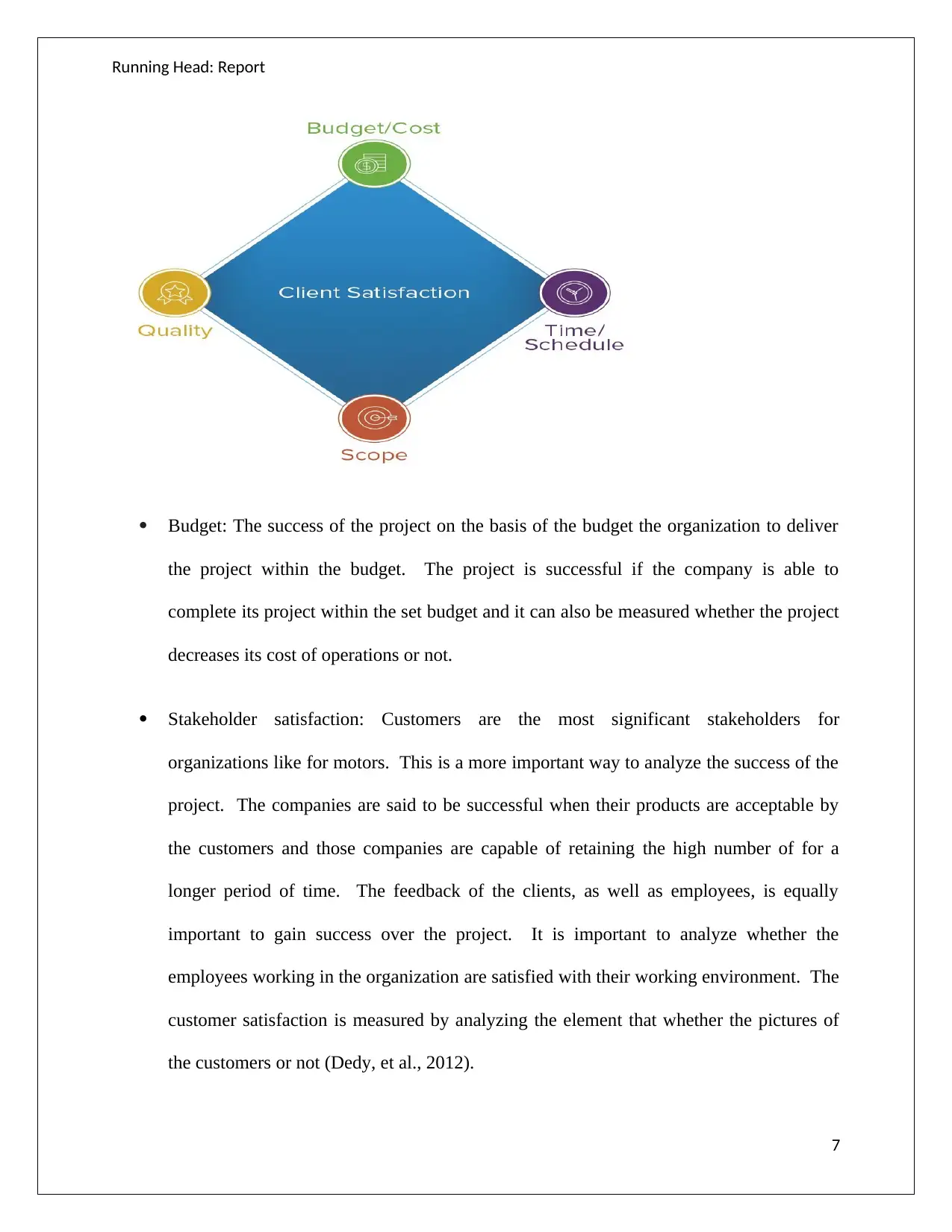
Running Head: Report
Budget: The success of the project on the basis of the budget the organization to deliver
the project within the budget. The project is successful if the company is able to
complete its project within the set budget and it can also be measured whether the project
decreases its cost of operations or not.
Stakeholder satisfaction: Customers are the most significant stakeholders for
organizations like for motors. This is a more important way to analyze the success of the
project. The companies are said to be successful when their products are acceptable by
the customers and those companies are capable of retaining the high number of for a
longer period of time. The feedback of the clients, as well as employees, is equally
important to gain success over the project. It is important to analyze whether the
employees working in the organization are satisfied with their working environment. The
customer satisfaction is measured by analyzing the element that whether the pictures of
the customers or not (Dedy, et al., 2012).
7
Budget: The success of the project on the basis of the budget the organization to deliver
the project within the budget. The project is successful if the company is able to
complete its project within the set budget and it can also be measured whether the project
decreases its cost of operations or not.
Stakeholder satisfaction: Customers are the most significant stakeholders for
organizations like for motors. This is a more important way to analyze the success of the
project. The companies are said to be successful when their products are acceptable by
the customers and those companies are capable of retaining the high number of for a
longer period of time. The feedback of the clients, as well as employees, is equally
important to gain success over the project. It is important to analyze whether the
employees working in the organization are satisfied with their working environment. The
customer satisfaction is measured by analyzing the element that whether the pictures of
the customers or not (Dedy, et al., 2012).
7
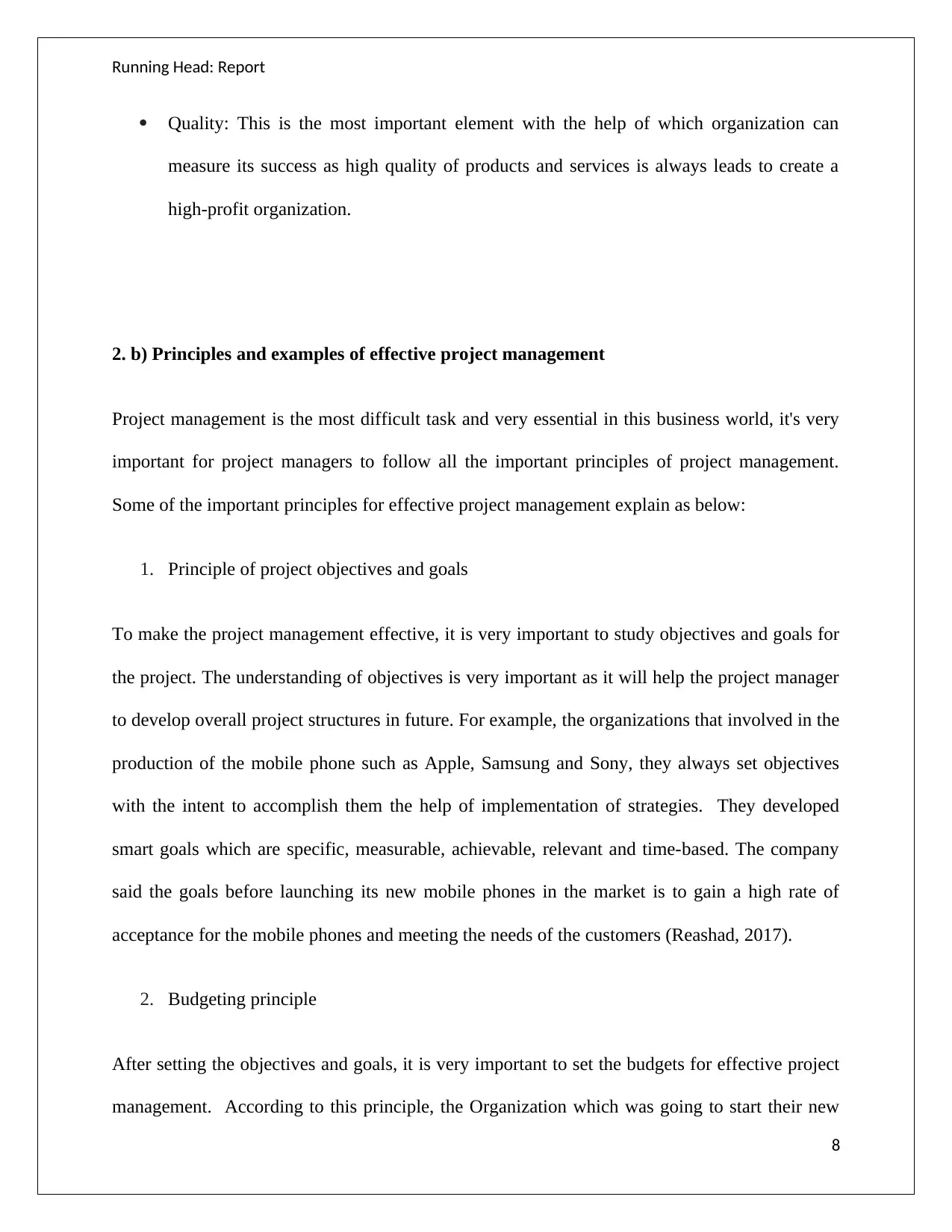
Running Head: Report
Quality: This is the most important element with the help of which organization can
measure its success as high quality of products and services is always leads to create a
high-profit organization.
2. b) Principles and examples of effective project management
Project management is the most difficult task and very essential in this business world, it's very
important for project managers to follow all the important principles of project management.
Some of the important principles for effective project management explain as below:
1. Principle of project objectives and goals
To make the project management effective, it is very important to study objectives and goals for
the project. The understanding of objectives is very important as it will help the project manager
to develop overall project structures in future. For example, the organizations that involved in the
production of the mobile phone such as Apple, Samsung and Sony, they always set objectives
with the intent to accomplish them the help of implementation of strategies. They developed
smart goals which are specific, measurable, achievable, relevant and time-based. The company
said the goals before launching its new mobile phones in the market is to gain a high rate of
acceptance for the mobile phones and meeting the needs of the customers (Reashad, 2017).
2. Budgeting principle
After setting the objectives and goals, it is very important to set the budgets for effective project
management. According to this principle, the Organization which was going to start their new
8
Quality: This is the most important element with the help of which organization can
measure its success as high quality of products and services is always leads to create a
high-profit organization.
2. b) Principles and examples of effective project management
Project management is the most difficult task and very essential in this business world, it's very
important for project managers to follow all the important principles of project management.
Some of the important principles for effective project management explain as below:
1. Principle of project objectives and goals
To make the project management effective, it is very important to study objectives and goals for
the project. The understanding of objectives is very important as it will help the project manager
to develop overall project structures in future. For example, the organizations that involved in the
production of the mobile phone such as Apple, Samsung and Sony, they always set objectives
with the intent to accomplish them the help of implementation of strategies. They developed
smart goals which are specific, measurable, achievable, relevant and time-based. The company
said the goals before launching its new mobile phones in the market is to gain a high rate of
acceptance for the mobile phones and meeting the needs of the customers (Reashad, 2017).
2. Budgeting principle
After setting the objectives and goals, it is very important to set the budgets for effective project
management. According to this principle, the Organization which was going to start their new
8
⊘ This is a preview!⊘
Do you want full access?
Subscribe today to unlock all pages.

Trusted by 1+ million students worldwide
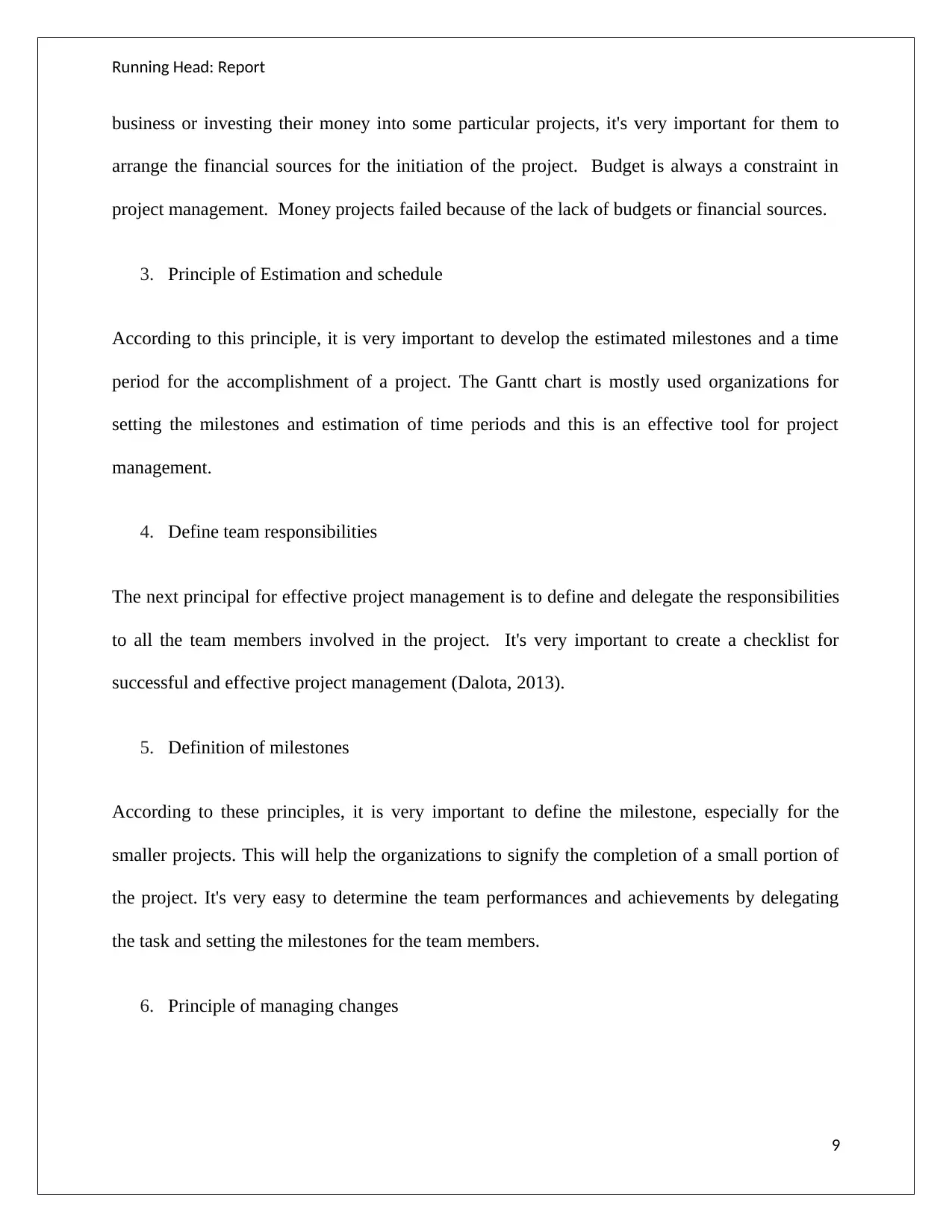
Running Head: Report
business or investing their money into some particular projects, it's very important for them to
arrange the financial sources for the initiation of the project. Budget is always a constraint in
project management. Money projects failed because of the lack of budgets or financial sources.
3. Principle of Estimation and schedule
According to this principle, it is very important to develop the estimated milestones and a time
period for the accomplishment of a project. The Gantt chart is mostly used organizations for
setting the milestones and estimation of time periods and this is an effective tool for project
management.
4. Define team responsibilities
The next principal for effective project management is to define and delegate the responsibilities
to all the team members involved in the project. It's very important to create a checklist for
successful and effective project management (Dalota, 2013).
5. Definition of milestones
According to these principles, it is very important to define the milestone, especially for the
smaller projects. This will help the organizations to signify the completion of a small portion of
the project. It's very easy to determine the team performances and achievements by delegating
the task and setting the milestones for the team members.
6. Principle of managing changes
9
business or investing their money into some particular projects, it's very important for them to
arrange the financial sources for the initiation of the project. Budget is always a constraint in
project management. Money projects failed because of the lack of budgets or financial sources.
3. Principle of Estimation and schedule
According to this principle, it is very important to develop the estimated milestones and a time
period for the accomplishment of a project. The Gantt chart is mostly used organizations for
setting the milestones and estimation of time periods and this is an effective tool for project
management.
4. Define team responsibilities
The next principal for effective project management is to define and delegate the responsibilities
to all the team members involved in the project. It's very important to create a checklist for
successful and effective project management (Dalota, 2013).
5. Definition of milestones
According to these principles, it is very important to define the milestone, especially for the
smaller projects. This will help the organizations to signify the completion of a small portion of
the project. It's very easy to determine the team performances and achievements by delegating
the task and setting the milestones for the team members.
6. Principle of managing changes
9
Paraphrase This Document
Need a fresh take? Get an instant paraphrase of this document with our AI Paraphraser
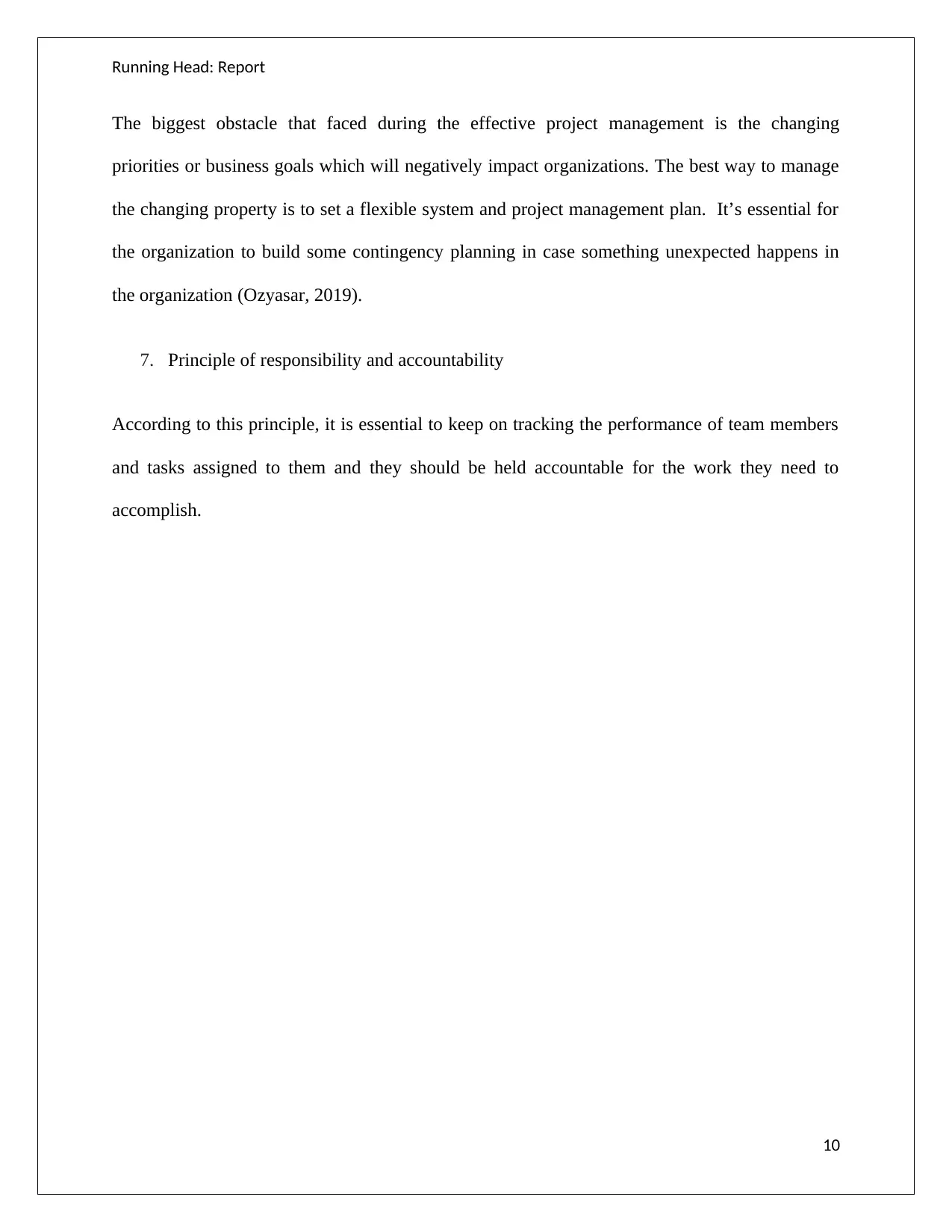
Running Head: Report
The biggest obstacle that faced during the effective project management is the changing
priorities or business goals which will negatively impact organizations. The best way to manage
the changing property is to set a flexible system and project management plan. It’s essential for
the organization to build some contingency planning in case something unexpected happens in
the organization (Ozyasar, 2019).
7. Principle of responsibility and accountability
According to this principle, it is essential to keep on tracking the performance of team members
and tasks assigned to them and they should be held accountable for the work they need to
accomplish.
10
The biggest obstacle that faced during the effective project management is the changing
priorities or business goals which will negatively impact organizations. The best way to manage
the changing property is to set a flexible system and project management plan. It’s essential for
the organization to build some contingency planning in case something unexpected happens in
the organization (Ozyasar, 2019).
7. Principle of responsibility and accountability
According to this principle, it is essential to keep on tracking the performance of team members
and tasks assigned to them and they should be held accountable for the work they need to
accomplish.
10
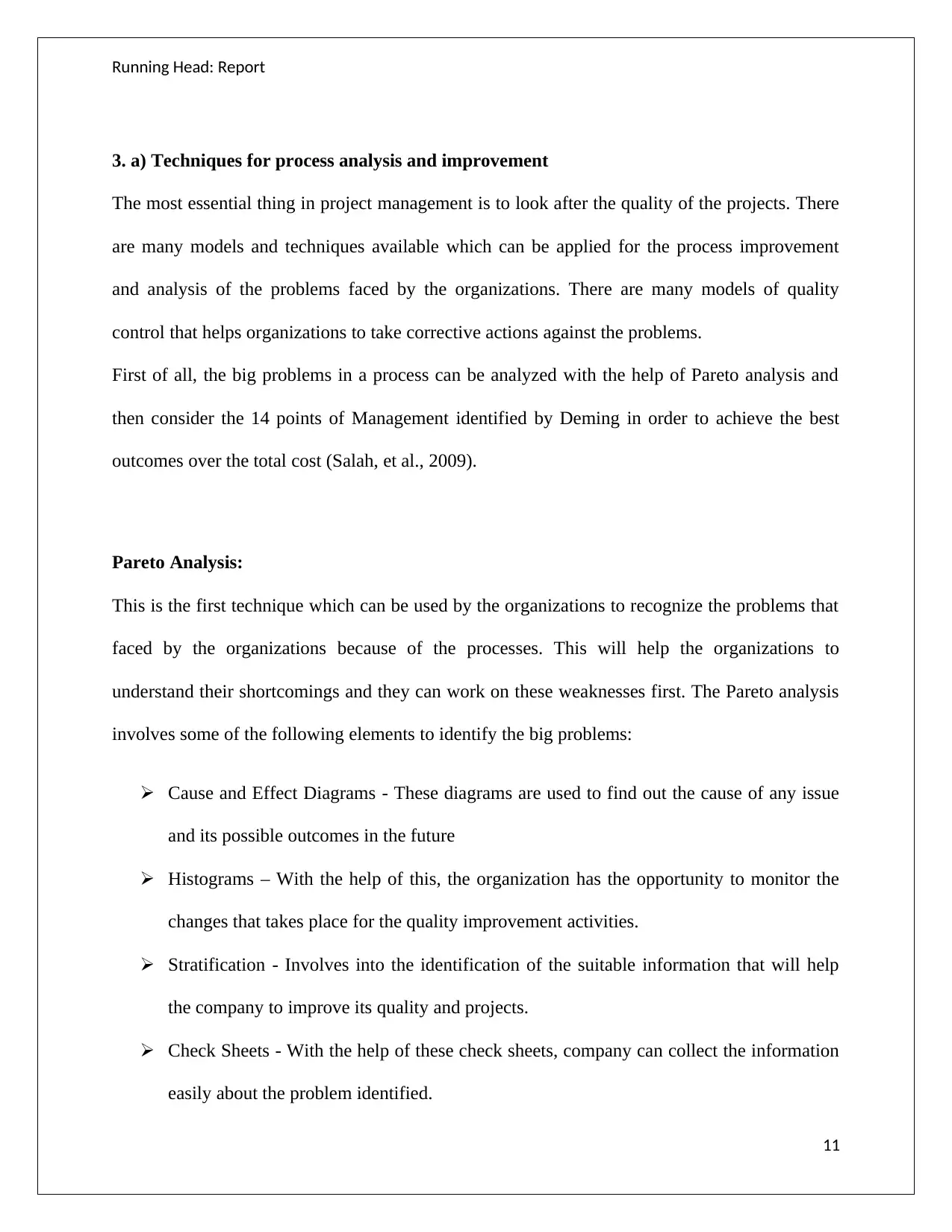
Running Head: Report
3. a) Techniques for process analysis and improvement
The most essential thing in project management is to look after the quality of the projects. There
are many models and techniques available which can be applied for the process improvement
and analysis of the problems faced by the organizations. There are many models of quality
control that helps organizations to take corrective actions against the problems.
First of all, the big problems in a process can be analyzed with the help of Pareto analysis and
then consider the 14 points of Management identified by Deming in order to achieve the best
outcomes over the total cost (Salah, et al., 2009).
Pareto Analysis:
This is the first technique which can be used by the organizations to recognize the problems that
faced by the organizations because of the processes. This will help the organizations to
understand their shortcomings and they can work on these weaknesses first. The Pareto analysis
involves some of the following elements to identify the big problems:
Cause and Effect Diagrams - These diagrams are used to find out the cause of any issue
and its possible outcomes in the future
Histograms – With the help of this, the organization has the opportunity to monitor the
changes that takes place for the quality improvement activities.
Stratification - Involves into the identification of the suitable information that will help
the company to improve its quality and projects.
Check Sheets - With the help of these check sheets, company can collect the information
easily about the problem identified.
11
3. a) Techniques for process analysis and improvement
The most essential thing in project management is to look after the quality of the projects. There
are many models and techniques available which can be applied for the process improvement
and analysis of the problems faced by the organizations. There are many models of quality
control that helps organizations to take corrective actions against the problems.
First of all, the big problems in a process can be analyzed with the help of Pareto analysis and
then consider the 14 points of Management identified by Deming in order to achieve the best
outcomes over the total cost (Salah, et al., 2009).
Pareto Analysis:
This is the first technique which can be used by the organizations to recognize the problems that
faced by the organizations because of the processes. This will help the organizations to
understand their shortcomings and they can work on these weaknesses first. The Pareto analysis
involves some of the following elements to identify the big problems:
Cause and Effect Diagrams - These diagrams are used to find out the cause of any issue
and its possible outcomes in the future
Histograms – With the help of this, the organization has the opportunity to monitor the
changes that takes place for the quality improvement activities.
Stratification - Involves into the identification of the suitable information that will help
the company to improve its quality and projects.
Check Sheets - With the help of these check sheets, company can collect the information
easily about the problem identified.
11
⊘ This is a preview!⊘
Do you want full access?
Subscribe today to unlock all pages.

Trusted by 1+ million students worldwide
1 out of 23
Related Documents
Your All-in-One AI-Powered Toolkit for Academic Success.
+13062052269
info@desklib.com
Available 24*7 on WhatsApp / Email
![[object Object]](/_next/static/media/star-bottom.7253800d.svg)
Unlock your academic potential
Copyright © 2020–2025 A2Z Services. All Rights Reserved. Developed and managed by ZUCOL.





